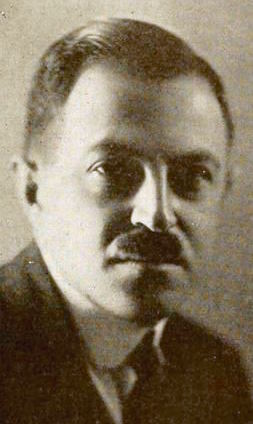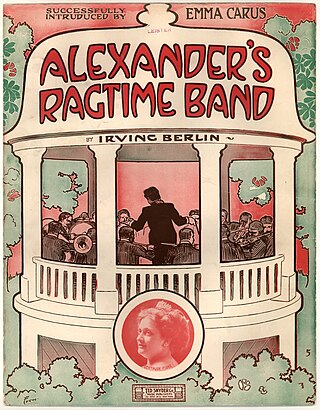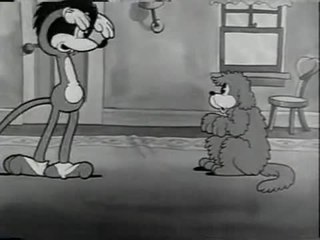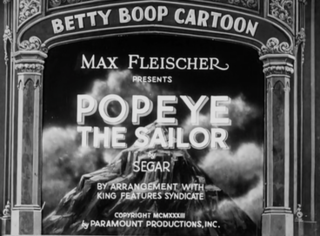
Fleischer Studios was an American animation studio founded in 1929 by brothers Max and Dave Fleischer, who ran the pioneering company from its inception until its acquisition by Paramount Pictures, the parent company and the distributor of its films. In its prime, Fleischer Studios was a premier producer of animated cartoons for theaters, with Walt Disney Productions being its chief competitor in the 1930s.

Max Fleischer was a Polish-American animator, inventor, film director and producer, and studio founder and owner. Born in Kraków, Poland, Fleischer immigrated to the United States where he became a pioneer in the development of the animated cartoon and served as the head of Fleischer Studios, which he co-founded with his younger brother Dave. He brought such comic characters as Koko the Clown, Betty Boop, Popeye, and Superman to the movie screen, and was responsible for several technological innovations, including the rotoscope, the "follow the bouncing ball" technique pioneered in the Ko-Ko Song Car-Tunes films, and the "stereoptical process". Film director Richard Fleischer was his son.

Winfield B. Mercer, professionally known as Jack Mercer, was a prolific American voice actor, animator and TV screenwriter. He is best known as the voice of cartoon characters Popeye the Sailor Man and Felix the Cat. The son of vaudeville and Broadway performers, he also performed on the vaudeville and legitimate stages.

The Fleischer Superman cartoons are a series of seventeen animated superhero short films released in Technicolor by Paramount Pictures and based upon the comic book character Superman, making them his first animated appearance.

Famous Studios was the first animation division of the film studio Paramount Pictures from 1942 to 1967. Famous was founded as a successor company to Fleischer Studios, after Paramount seized control of the aforementioned studio after the departure of its founders, Max and Dave Fleischer, in 1942. The studio's productions included three series started by the Fleischers—Popeye the Sailor, Superman, and Screen Songs—as well as Little Audrey, Little Lulu, Casper the Friendly Ghost, Honey Halfwitch, Herman and Katnip, Baby Huey, and the anthology Noveltoons series.

Popeye the Sailor Meets Sindbad the Sailor is a 1936 two-reel animated cartoon short subject in the Popeye Color Specials series, produced in Technicolor and released to theatres on November 27, 1936, by Paramount Pictures. It was produced by Max Fleischer for Fleischer Studios, Inc. and directed by Dave Fleischer, with the title song's music composed by Sammy Timberg and lyrics written by Bob Rothberg. The voice cast includes Jack Mercer as Popeye, Gus Wickie as Sindbad the Sailor, Mae Questel as Olive Oyl and Lou Fleischer as J. Wellington Wimpy.

Popeye the Sailor Meets Ali Baba's Forty Thieves is a two-reel animated cartoon short subject in the Popeye Color Specials series, produced in Technicolor and released to theatres on November 26, 1937 by Paramount Pictures. It was produced by Max Fleischer for Fleischer Studios, Inc. and directed by Dave Fleischer. Willard Bowsky was head animator, with musical supervision by Sammy Timberg. The voice of Popeye is performed by Jack Mercer, with additional voices by Mae Questel as Olive Oyl, Lou Fleischer as J. Wellington Wimpy and Gus Wickie as Abu Hassan.

Aladdin and His Wonderful Lamp is a two-reel animated cartoon short subject in the Popeye Color Specials series, produced in Technicolor and released to theaters on April 7, 1939, by Paramount Pictures. It was produced by Max Fleischer, and directed by Dave Fleischer for Fleischer Studios, Inc., with David Tendlar serving as head animator, and music being supervised by Sammy Timberg. The voice of Popeye is performed by Jack Mercer, with additional voices by Margie Hines as Olive Oyl and Carl Meyer as the evil Wazzir.

Screen Songs are a series of animated cartoons produced at the Fleischer Studios and distributed by Paramount Pictures between 1929 and 1938. Paramount brought back the sing-along cartoons in 1945, now in color, and released them regularly through 1951. Two of Paramount's one-shot cartoons quietly revived the format later: Candy Cabaret (1954) and Hobo's Holiday (1963).

The bouncing ball is a virtual device used in motion picture films and video recordings to visually indicate the rhythm of a song, helping audiences to sing along with live or prerecorded music. As the song's lyrics are displayed on the screen in a lower third of projected or character-generated text, an animated ball bounces across the top of the words, landing on each syllable when it is to be sung.

Gulliver's Travels is an American animated musical fantasy film produced by Max Fleischer and directed by Dave Fleischer for Fleischer Studios. Released to cinemas in the United States on December 22, 1939, by Paramount Pictures, the story is a very loose adaptation of Jonathan Swift's 1726 novel of the same name, specifically only the first part of four, which tells the story of Lilliput and Blefuscu, and centers around an explorer who helps a small kingdom who declared war after an argument over a wedding song. The film was Fleischer Studios' first feature-length animated film, as well as the second animated feature film produced by an American studio after Walt Disney Productions' Snow White and the Seven Dwarfs, as Paramount had commissioned the feature in response to the success of that film. The sequences for the film were directed by Seymour Kneitel, Willard Bowsky, Tom Palmer, Grim Natwick, William Henning, Roland Crandall, Thomas Johnson, Robert Leffingwell, Frank Kelling, Winfield Hoskins, and Orestes Calpini.

Popeye the Sailor is a 1933 animated short produced by Fleischer Studios and distributed by Paramount Publix Corporation. While billed as a Betty Boop cartoon, it was produced as a vehicle for Popeye in his debut animated appearance.
Seymour Kneitel was an American animator, best known for his work with Fleischer Studios and its successor, Famous Studios.
Ko-Ko Song Car-Tunes, Song Car-Tunes, or Sound Car-Tunes, is a series of short three-minute animated films produced by Max Fleischer and Dave Fleischer between May 1924 and September 1927, pioneering the use of the "Follow the Bouncing Ball" device used to lead audiences in theater sing-alongs. The Song Car-Tunes also pioneered the application of sound film to animation.

Christmas Comes But Once a Year is a 1936 animated short produced by Fleischer Studios and released on December 4, 1936 by Paramount Pictures. It is part of the Color Classics series. The cartoon features Professor Grampy, a character from the Betty Boop series; this is the character's only appearance without Betty. An edited version was featured during the Pee-wee's Playhouse Christmas Special in 1988, as the featured short shown by the King of Cartoons.
Samuel Lerner was a Romanian-born songwriter for American and British musical theatre and film.
The Popeye Song Folio is a collection of 24 songs issued by Popular Melodies, Inc. 1619 Broadway, New York City in 1936. They contain the tunes played in the various Popeye cartoon short series directed by Dave Fleischer.

Popeye the Sailor is an American animated series of short films based on the Popeye comic strip character created by E. C. Segar. In 1933, Max and Dave Fleischer's Fleischer Studios, based in New York City, adapted Segar's characters into a series of theatrical cartoon shorts for Paramount Pictures. The plotlines in the animated cartoons tended to be simpler than those presented in the comic strips, and the characters slightly different. A villain, usually Bluto, makes a move on Popeye's "sweetie", Olive Oyl. The villain clobbers Popeye until he eats spinach, giving him superhuman strength. Thus empowered, Popeye makes short work of the villain.

Winston Singleton Sharples was an American composer known for his work with animated short subjects, especially those created by the animation department at Paramount Pictures. In his 35-year career, Sharples scored more than 700 cartoons for Paramount and Famous Studios, and composed music for two Frank Buck films, Wild Cargo (1934) and Fang and Claw (1935).

Popeye the Sailor is a fictional cartoon character created by Elzie Crisler Segar. The character first appeared on January 17, 1929, in the daily King Features comic strip Thimble Theatre. The strip was in its tenth year when Popeye made his debut, but the one-eyed sailor quickly became the lead character, and Thimble Theatre became one of King Features' most popular properties during the 1930s. Following Segar's death in 1938, Thimble Theatre was continued by several writers and artists, most notably Segar's assistant Bud Sagendorf. It was formally renamed Popeye. The strip continues to appear in first-run installments on Sundays, written and drawn by R.K. Milholland. The daily strips are reprints of old Sagendorf stories.
















